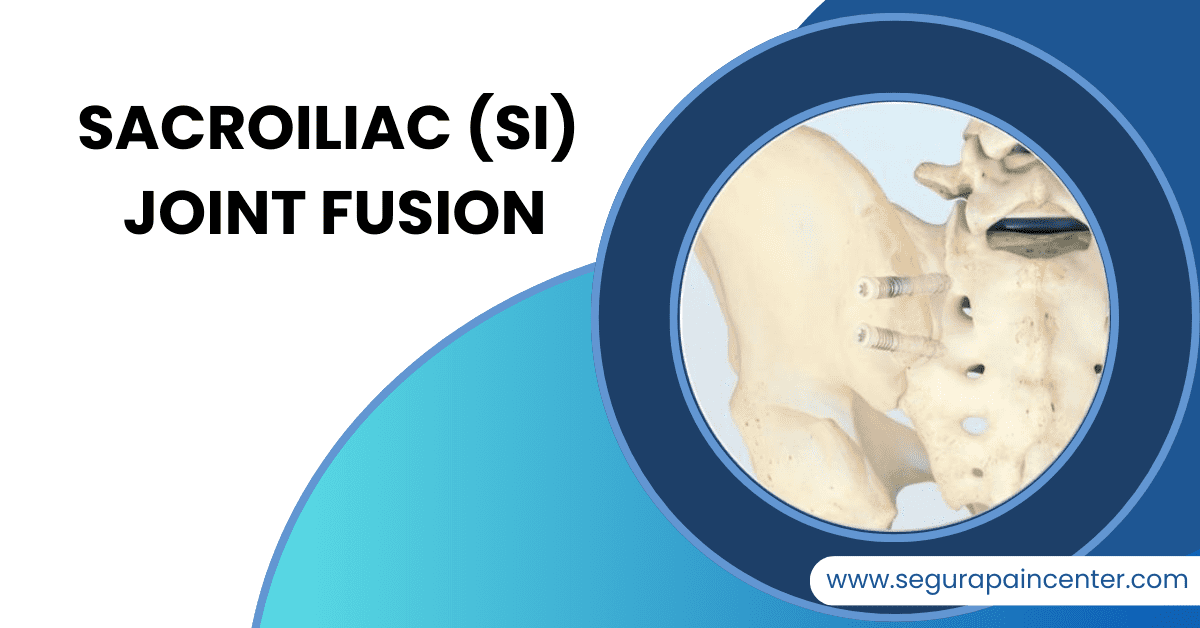
Sacroiliac (SI) joint fusion is a procedure used to treat chronic pain and dysfunction in the sacroiliac joint. The SI joints are located where the lower spine meets the pelvis. You have two SI joints, one on each side of your lower back, just above your buttocks. These joints connect the sacrum (the triangular bone at the base of the spine) to the iliac bones (the large bones that form the pelvis).
What Do SI Joints Actually Do?
These complex joints play a key role in your body by supporting your upper body and transferring weight and force between your upper body and legs when you walk, run, or move. Although the SI joints have limited movement, they provide stability to your lower back and hips. Additionally, they absorb shock from activities such as walking or jumping, helping reduce strain on the spine and pelvis. Pain in the SI joint can occur due to injury, wear and tear, or inflammation, leading to discomfort in your lower back, buttocks, and legs. Treatment often includes physical therapy, exercises, or injections to improve function and relieve pain.
When Would an SI Joint Fusion Be Considered?
SI joint fusion is typically recommended when conservative treatments—such as physical therapy, medications, or joint injections—fail to provide relief for chronic pain or dysfunction. The decision to undergo SI joint fusion is made when the joint's movement causes ongoing pain and disability that significantly impact daily life. If these non-surgical methods do not provide significant long-term relief, and imaging confirms the SI joint as the source of pain, fusion may be considered.
What Conditions May Benefit from a SI Joint Fusion?
Conditions that may benefit from SI joint fusion include:
Sacroiliac Joint Dysfunction (SIJD)
Sacroiliac Joint Dysfunction (SIJD) refers to abnormal movement or inflammation in the sacroiliac joint, which can lead to pain in the lower back, buttocks, and sometimes the legs. Conditions that fall under SIJD include Sacroiliac Joint Instability, where the joint becomes unstable due to injury, degeneration, or pregnancy, leading to chronic pain, as well as Trauma-related Sacroiliac Joint Injuries, which involve joint damage caused by accidents, falls, or fractures affecting the sacroiliac joint.
Sacroiliitis
Sacroiliitis refers to inflammation of the sacroiliac joint, often caused by arthritis, infection, or trauma, leading to pain in the lower back and pelvis. Under this umbrella term are conditions such as Degenerative Sacroiliitis, which is typically associated with degenerative joint disease (osteoarthritis) in the sacroiliac joint, especially in older adults. This condition can result in severe pain that does not respond to less invasive treatments like physical therapy or medications. Another related condition is Post-lumbar Fusion Pain (Adjacent Segment Disease), where patients develop sacroiliac joint pain after lumbar spine fusion surgery due to altered biomechanics that place more stress on the joint. Inflammatory Conditions, such as ankylosing spondylitis, can also affect the SI joints, potentially leading to significant damage or pain over time, which may eventually require fusion.
How Is an SI Joint Fusion Performed?
SI joint fusion is a minimally invasive procedure designed to stabilize the SI joint and relieve chronic pain. It involves the use of specialized implants to fuse the joint, stopping abnormal motion and providing long-term stability. Here's how the procedure works:
Preoperative Planning
Before the surgery, imaging studies (such as X-rays, CT scans, or MRIs) confirm that the SI joint is the source of pain and help the surgeon plan the procedure. These scans allow the surgeon to determine the exact size and placement of the implant.
Minimally Invasive Procedure
The surgery is performed through a small incision, minimizing tissue damage and leading to a quicker recovery time compared to traditional open surgery. Using fluoroscopic (X-ray) guidance, the surgeon places the necessary surgical instruments into the SI joint using a minimally invasive approach.
Placement of the Implant
The surgeon inserts a specially designed implant into the SI joint to facilitate fusion by creating a framework for bone to grow around over time. This implant encourages bone growth, providing stability to the joint as the fusion process occurs. Depending on the patient's anatomy and the surgeon’s evaluation, one or more implants may be placed.
Bone Growth and Fusion
The primary goal of SI joint fusion is to enable the bones of the sacrum and ilium, which form the SI joint, to fuse together over time. The implant provides immediate stabilization, while bone growth around and through the implant creates a permanent fusion. Its design promotes bone growth into and around the implant, leading to a strong and stable joint.
Postoperative Recovery
Due to the minimally invasive nature of the procedure, recovery is typically faster than with traditional open surgeries. Most patients are able to walk with assistance within a day or two after surgery, and physical therapy is often recommended to help restore strength and function. Over the course of several months, the bone fusion process continues to develop, usually resulting in a significant reduction in pain and improved mobility. As the bones fuse and stabilize the joint, patients typically experience long-term relief and a return to their normal activities.
Benefits of SI Joint Fusion
SI joint fusion offers several key benefits for patients suffering from chronic SI joint pain. As a minimally invasive procedure, it involves a smaller incision and less muscle damage, resulting in faster recovery times. The procedure is personalized and precise, with implants selected to fit each patient’s unique anatomy, providing optimal joint stabilization. By eliminating abnormal movement, SI joint fusion delivers effective pain relief, allowing patients to return to their daily activities much sooner compared to traditional surgeries.
If you or someone you know is experiencing chronic SI joint pain, contact Segura Neuroscience and Pain Center to learn if SI joint fusion may be the right solution for you.
Questions? Ask our doctors
Schedule a Consultation
